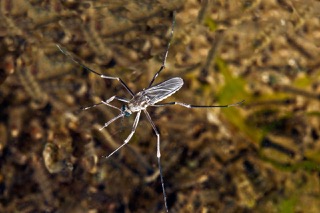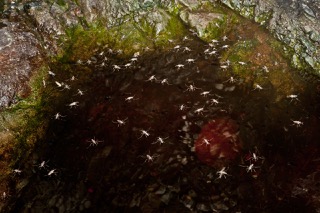Mosquito, Saltpool
Opifex fuscus
Naeroa
Mosquito, Salt marsh
Invertebrate
Arthropoda
Insecta
Culicidae

Rocky Shore Intertidal

Predator

New Zealand

Inedible

Coin Sized
A medium-sized to large, stocky, grey to brown dark mosquito with few scales. Head: vertex without erect scales, but with numerous curved setae (Belkin 1968). The body is dark grey-black and the wings are beige-brown.
Not many mosquitos are found in a salt environment, so this species is unusual, as it is only found on the rocky shore. They are usually found associated with rock pools at high tide and the larval stage is very tolerant of very varied environmental conditions.
The adult feeds on blood and isn't choosy. It will feed on birds, other coastal animals and of course humans, they feed by day and night, and their bite can be painful.. The larvae are predators who will feed on other small animals including other mosquito larvae, sometimes they will feed on the sediment at the bottom of their pool, cleaning off the organic matter.
Males have long legs that enable them to walk on water. They have large claws, which they use to grip females during mating (unlike many other mosquitoes, the saltpool female mates while still in the pupa stage). Adult females can produce their first batch of eggs without a meal of blood. The eggs are laid on the rocks just above the water and the larvae overwinter in the pools as pupae. The flies emerge in spring, with the male hatching first, so he can catch and mate with the females as they emerge.
Belkin, J. N, 1968. Mosquito studies (Diptera, Culicidae). VII. The Culicidae of New Zealand. Contr. Am. ent. Inst. 3 (1): 1-180. Photo Credit: Rod Morris. Photos available from www.rodmorris.co.nz

